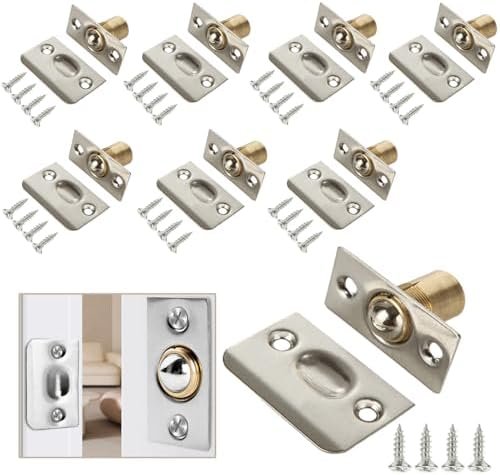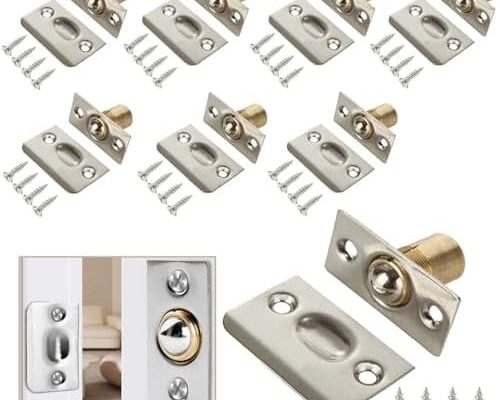
You might be wondering: “What are the best materials for door strike plates, and how do they differ?” Well, there are three main contenders: brass, steel, and plastic. Each has its own pros and cons, and the right choice for you will depend on your needs, budget, and personal style. Let’s dive into the world of door strike plates and see how these materials stack up against one another.
Understanding Door Strike Plates
Before we get into the specifics of materials, let’s clarify what a door strike plate is and why it matters. A strike plate is a metal plate attached to the door frame. Its primary function is to reinforce the area around the lock and help keep the door secured when closed. When the door is locked, the bolt extends into the strike plate, making it difficult for intruders to force the door open.
Now, you might be thinking: “Sounds important! But why should I care about the material?” Great question. The material of the strike plate impacts not only its strength and durability but also its compatibility with your door and lock system. Let’s explore the three most common materials: brass, steel, and plastic.
Brass Door Strike Plates
Brass is a classic choice for door strike plates, combining aesthetics with functionality. Known for its attractive golden hue, brass can add a touch of elegance to any door. But it’s not just about looks—brass is also resistant to corrosion, which means it stands up well to different weather conditions.
One of the main benefits of brass door strike plates is their strength. They can handle a fair amount of force, which is crucial for security. However, brass can be softer than other materials, making it more susceptible to dents over time. After years of use, you might find that the plate has lost its luster, but a good polishing can often restore its shine.
If you’re looking for a combination of beauty and decent security, brass might be your go-to option. Just keep in mind, if you’re in a high-traffic area or under heavy force, you may want to consider a more robust material.
Steel Door Strike Plates
Now let’s talk about steel. Steel door strike plates are often regarded as the heavyweight champions of door security. They are incredibly strong and resistant to bending or breaking. If you’re serious about security—say, you live in a high-crime area or just want the best protection for your family—steel is tough to beat.
One thing to note about steel is its durability. Unlike brass, steel won’t develop dings or dents easily. Plus, it’s less likely to warp or wear down over time, making it a wise investment for long-term use. However, the downside to steel is that it might not be as visually appealing as brass, especially if you prefer a more decorative look.
In addition, if you live in a humid area, be cautious. Steel can be prone to rust if not treated correctly. Look for galvanized or stainless-steel options, which will help prevent corrosion.
Plastic Door Strike Plates
Plastic is another option for door strike plates, especially in more budget-friendly settings. While it may not be as strong as brass or steel, plastic strike plates can still serve their purpose in low-traffic or interior doors. They are lightweight and often come in various colors, making them suitable for different décor styles.
One of the biggest perks of plastic strike plates is their affordability. If you’re renting or just need a quick fix, plastic can be a practical solution. That said, don’t expect them to stand up to much force. They might crack or break if subjected to an aggressive attempt to gain entry.
Plastic also doesn’t have the same aesthetic appeal as brass or steel. If you’re looking for something that blends in or elevates the appearance of your door, plastic might not be your best bet.
Comparing the Three Materials
So, how do these three materials stack up against each other? It often comes down to your priorities:
- Brass: Great for aesthetics and moderate security. Suits interior doors or low-traffic areas.
- Steel: The gold standard for strength and security. Best for exterior doors or high-risk zones.
- Plastic: Budget-friendly and suitable for low-risk cases but lacks durability and security.
When making a decision, consider where the strike plate will be installed. For entry doors, steel is often the best choice. For bedroom or bathroom doors, brass or even plastic could work just fine.
Installation Tips for Door Strike Plates
Regardless of the material you choose, proper installation is key to your door strike plate’s effectiveness. If the strike plate is misaligned or not securely fastened, it can create vulnerabilities. Here are some quick tips for installation:
1. Ensure Alignment: The strike plate should align perfectly with the bolt of the lock. If it’s off even slightly, it could make the lock less effective.
2. Use the Right Screws: When installing, use screws that are long enough to anchor the plate securely into the door frame. This extra strength can help resist force.
3. Check for Gaps: After installation, make sure there are no gaps between the plate and the door frame. Gaps can be an entry point for straining or forced entries.
Maintaining Your Door Strike Plates
Maintaining your door strike plates can extend their lifespan and improve your overall security. Here are a few simple steps you can take:
– Regular Inspections: Periodically check for wear and tear, especially on brass and plastic plates. Look for scratches, dents, or rust.
– Cleaning: For brass, a gentle polish can help restore shine. For steel, a damp cloth can remove dirt. Avoid harsh chemicals that might damage any finish.
– Tightening Screws: Make sure screws remain tight. It’s a simple fix that can make a big difference in security.
Final Thoughts on Door Strike Plates
Choosing the best material for your door strike plate is more than just a decorative choice; it’s a critical component of your home’s security. Whether you go for the elegance of brass, the strength of steel, or the affordability of plastic, understanding the pros and cons of each material will help you make the right decision.
Ultimately, consider your specific needs and the environment your door will face. With the right door strike plate, you can ensure that your home remains safe and sound. Now that you know the ins and outs of door strike plates, you can confidently choose the best option for your home. Remember, good security starts with small details—like the strike plate.
